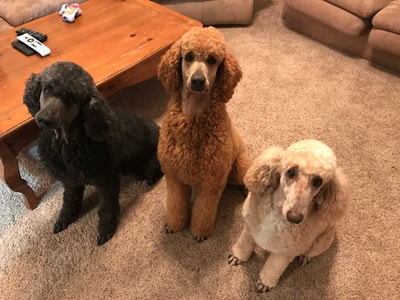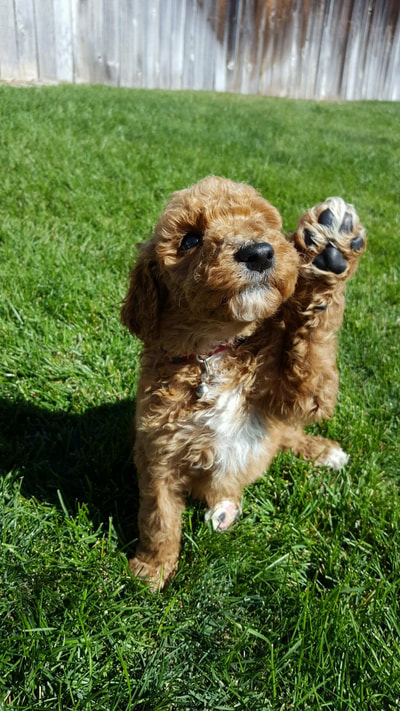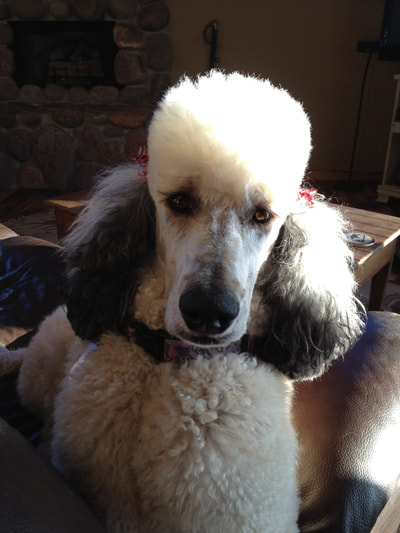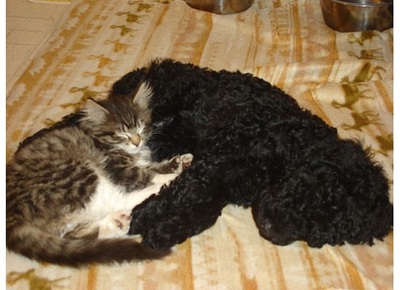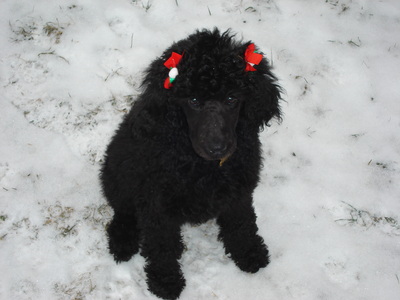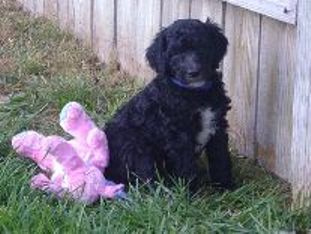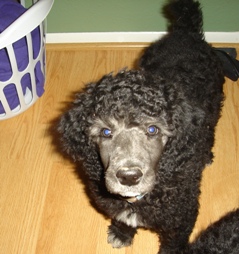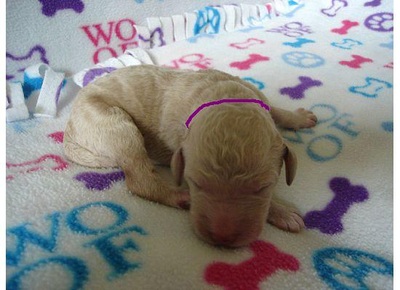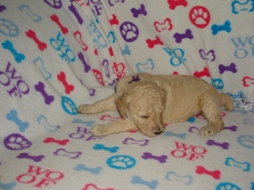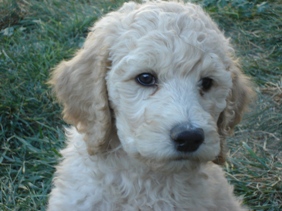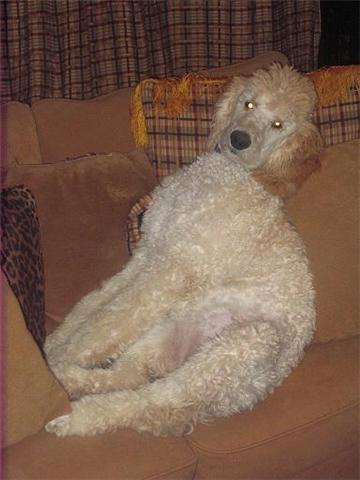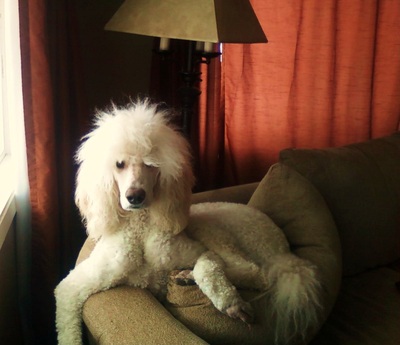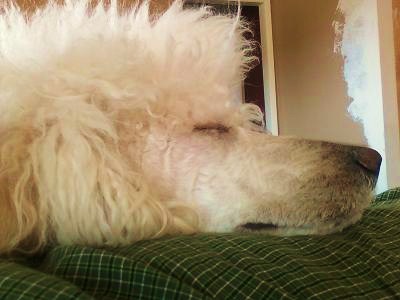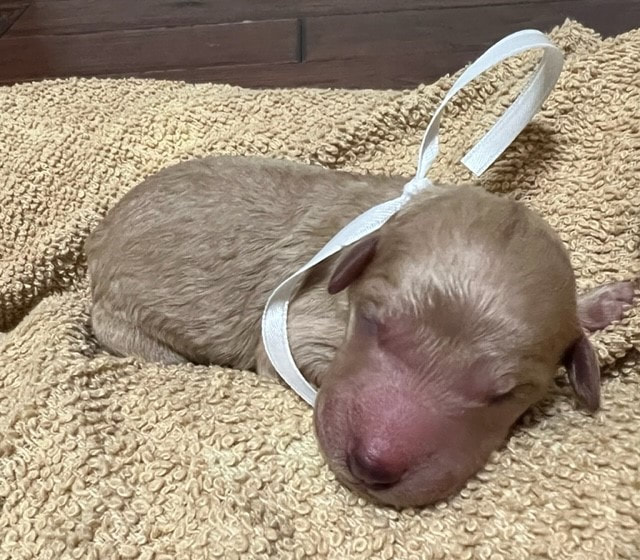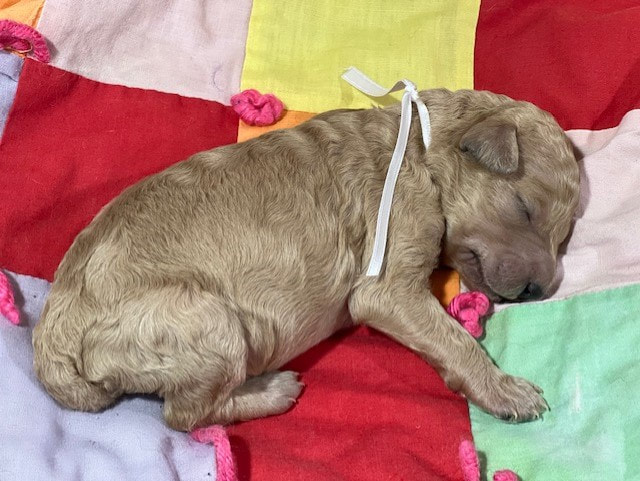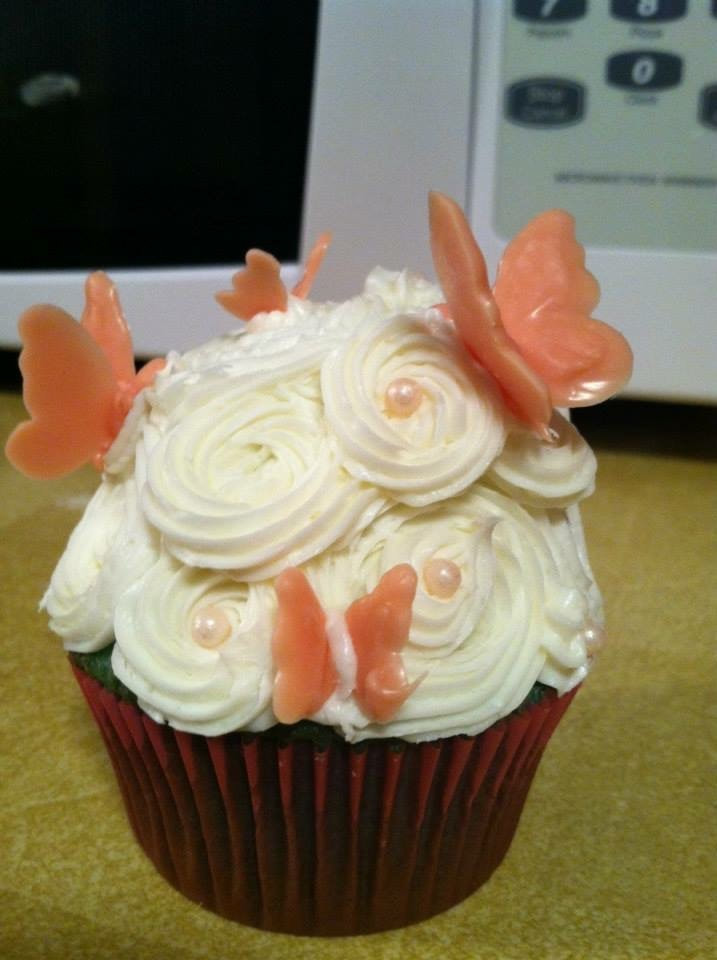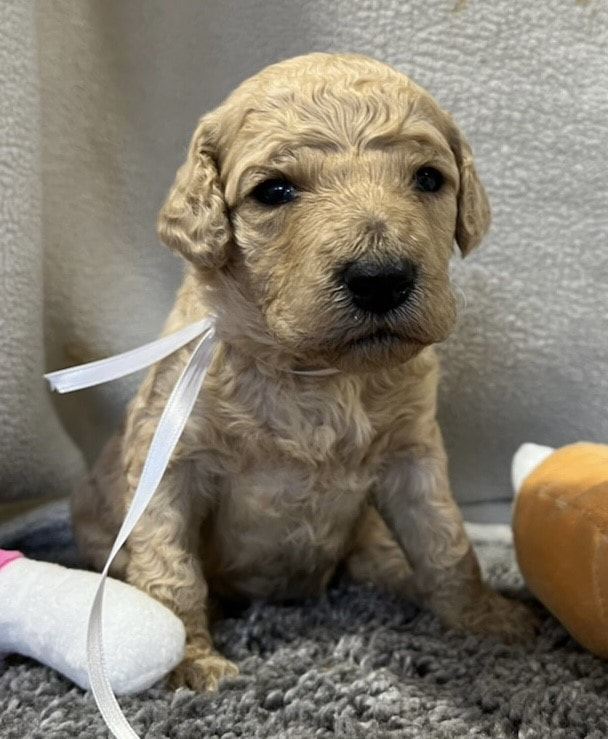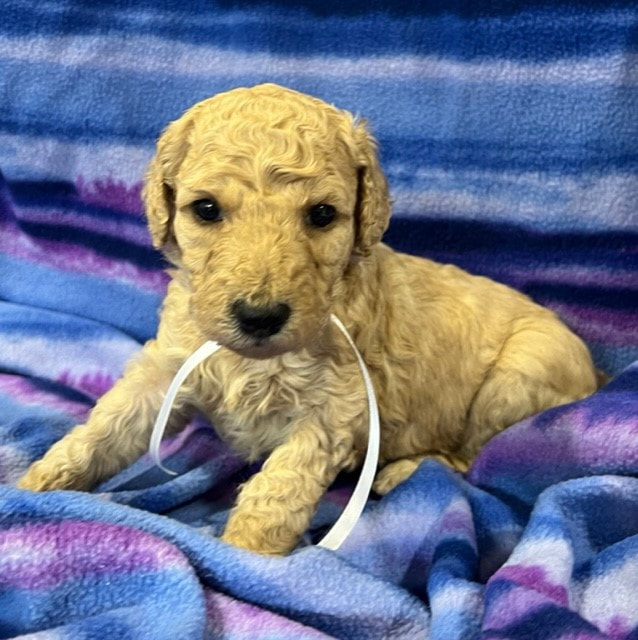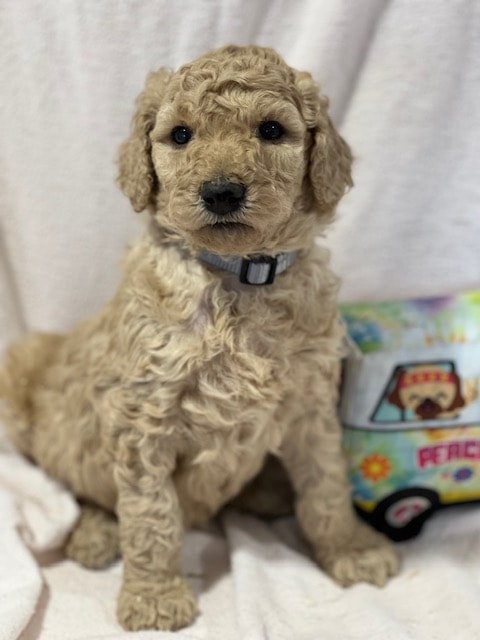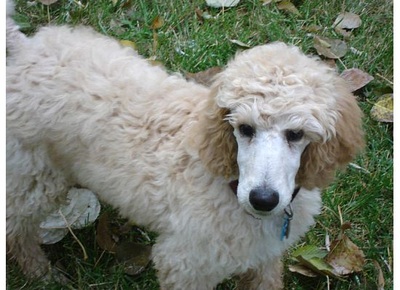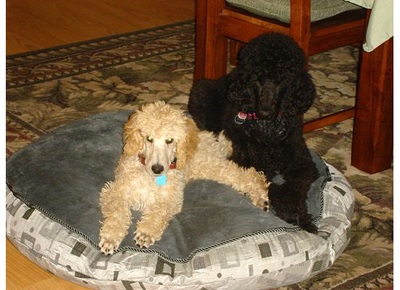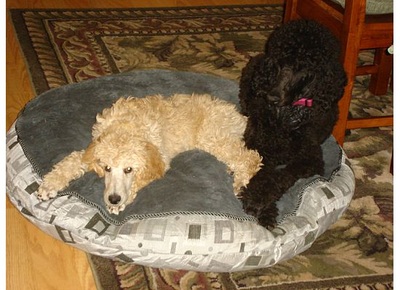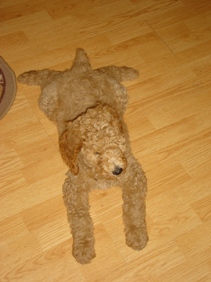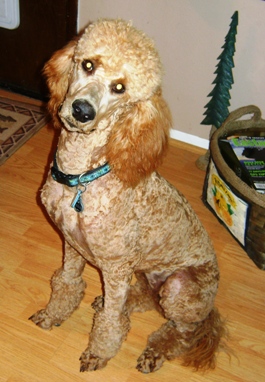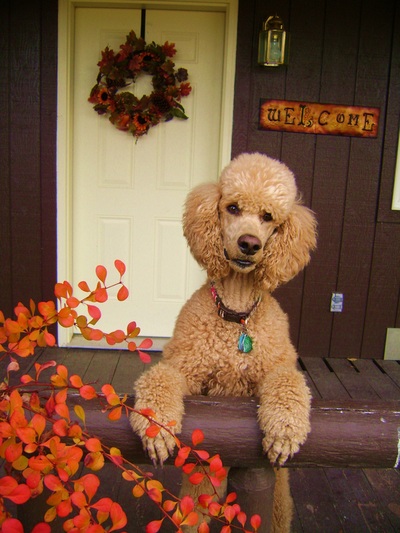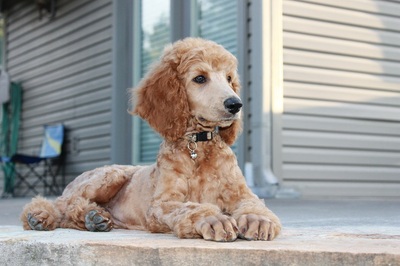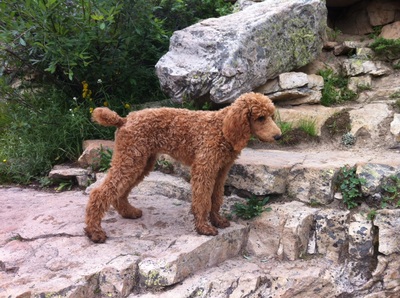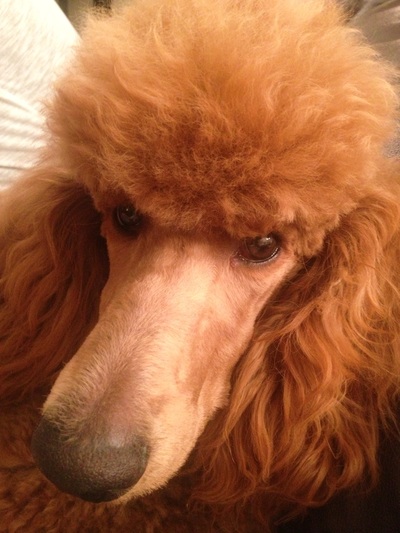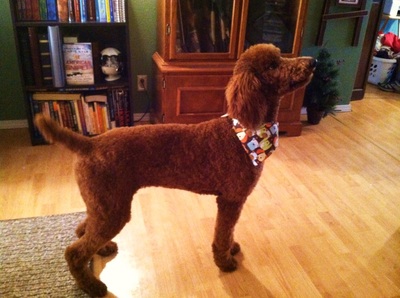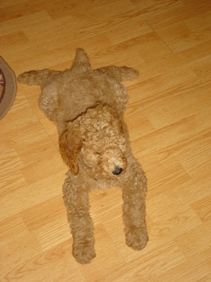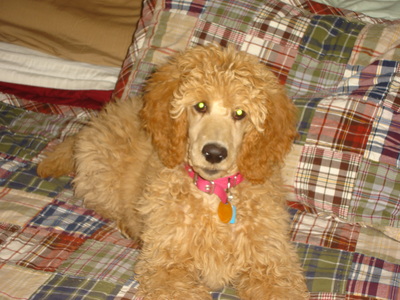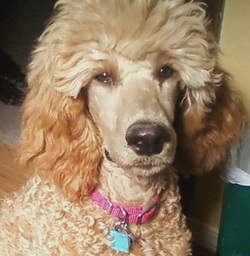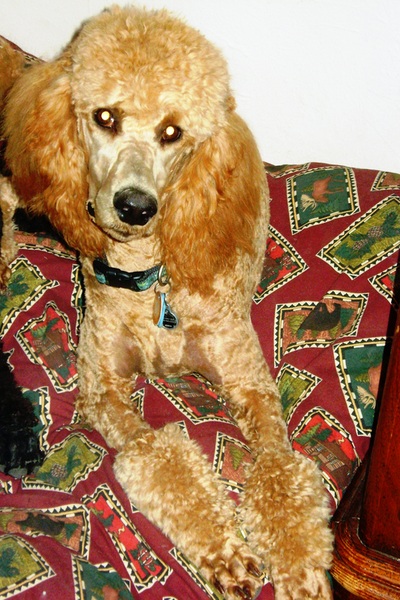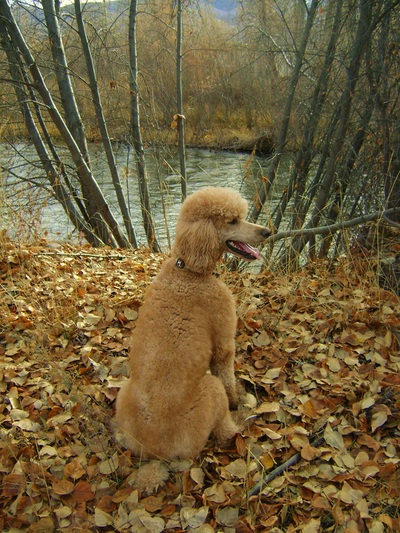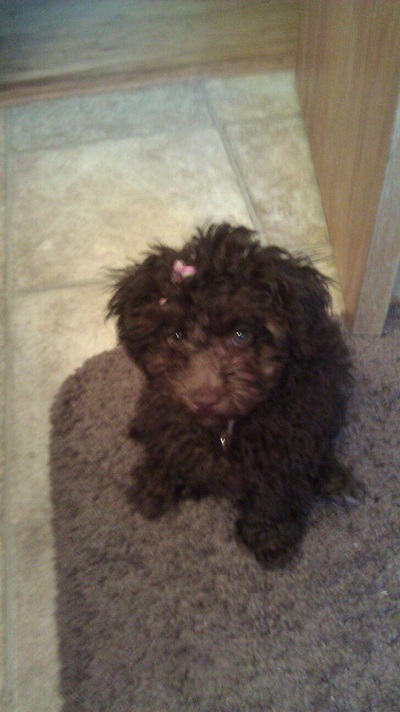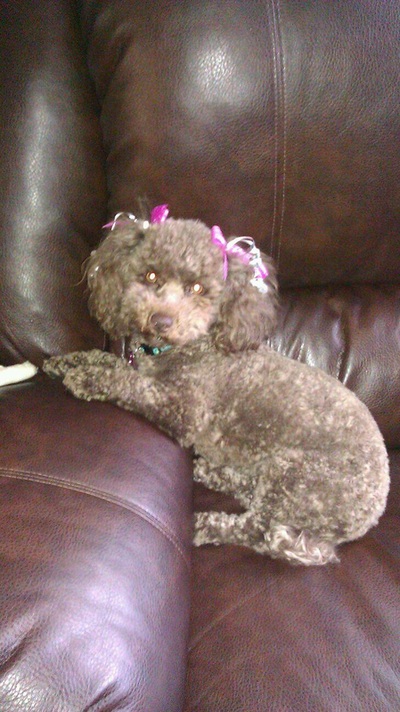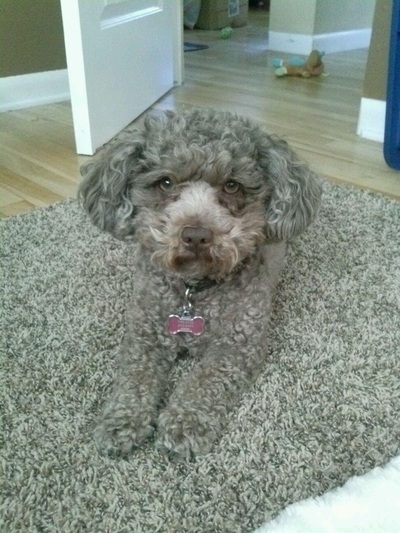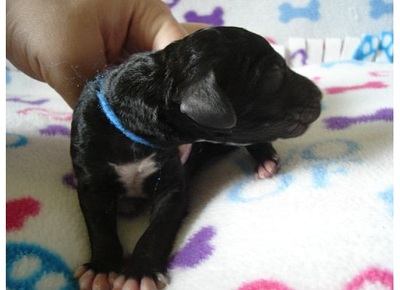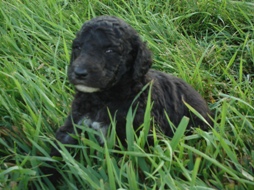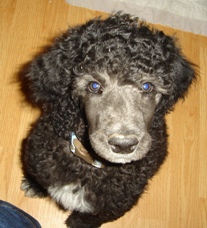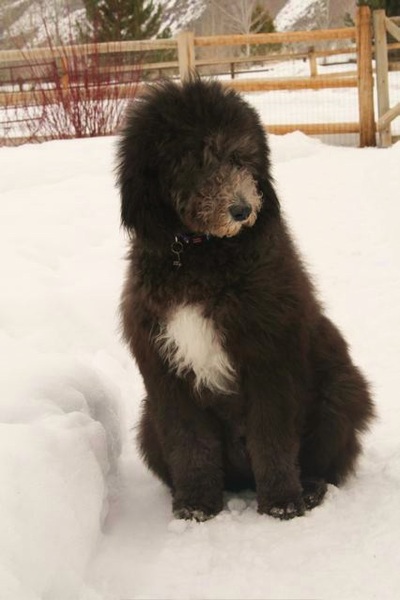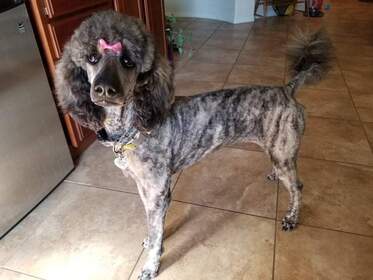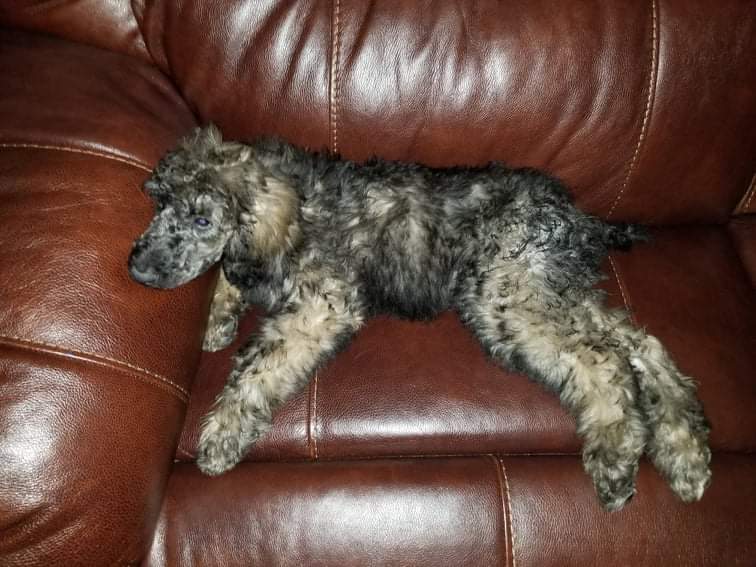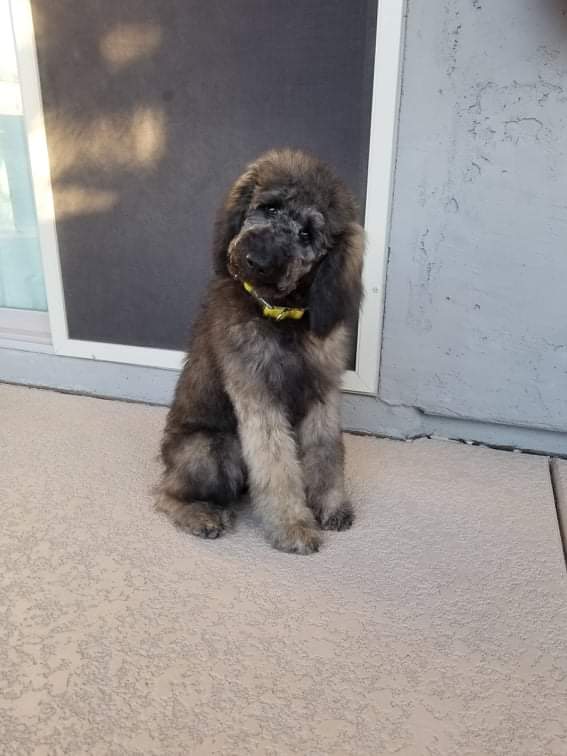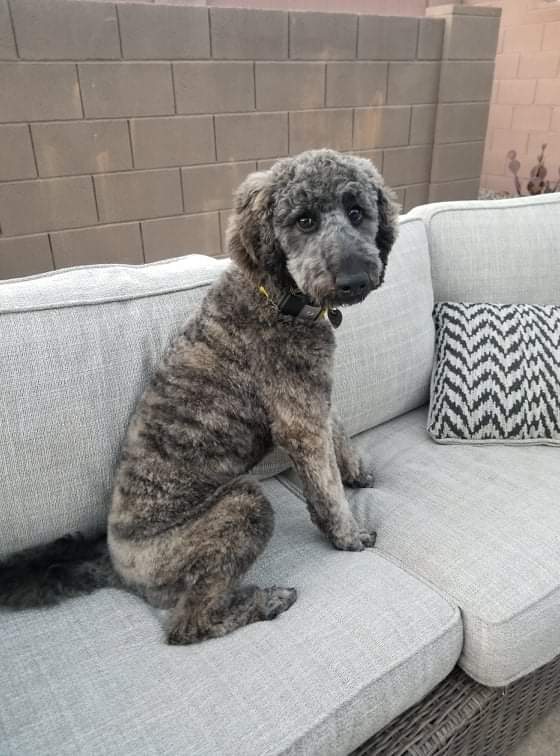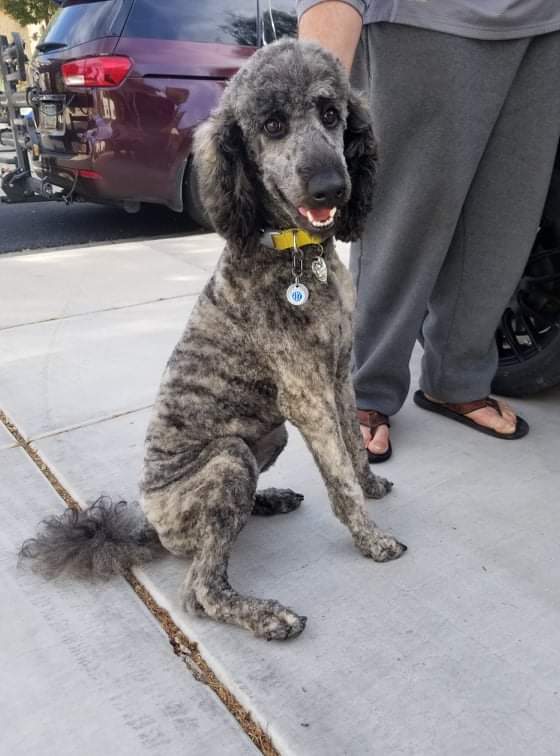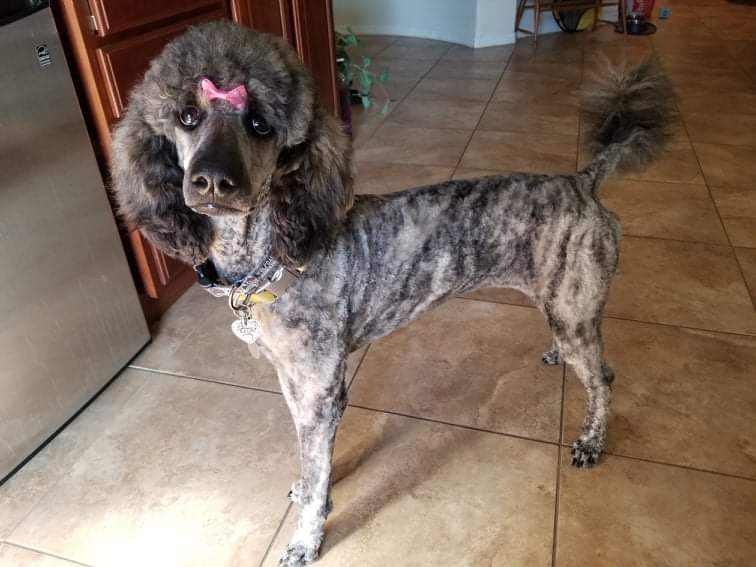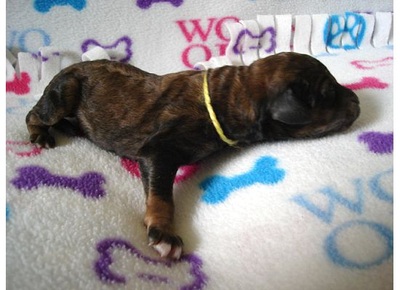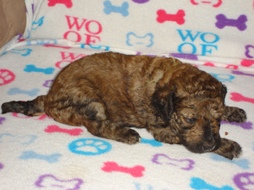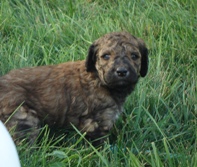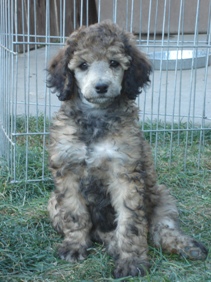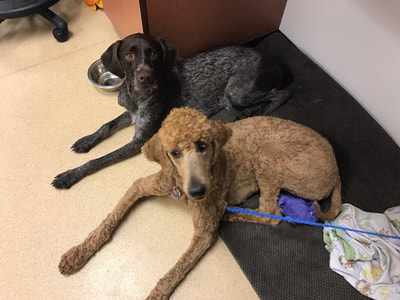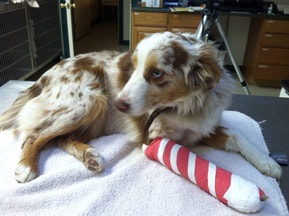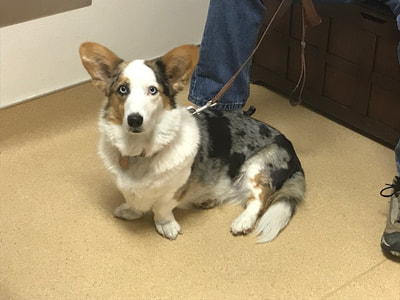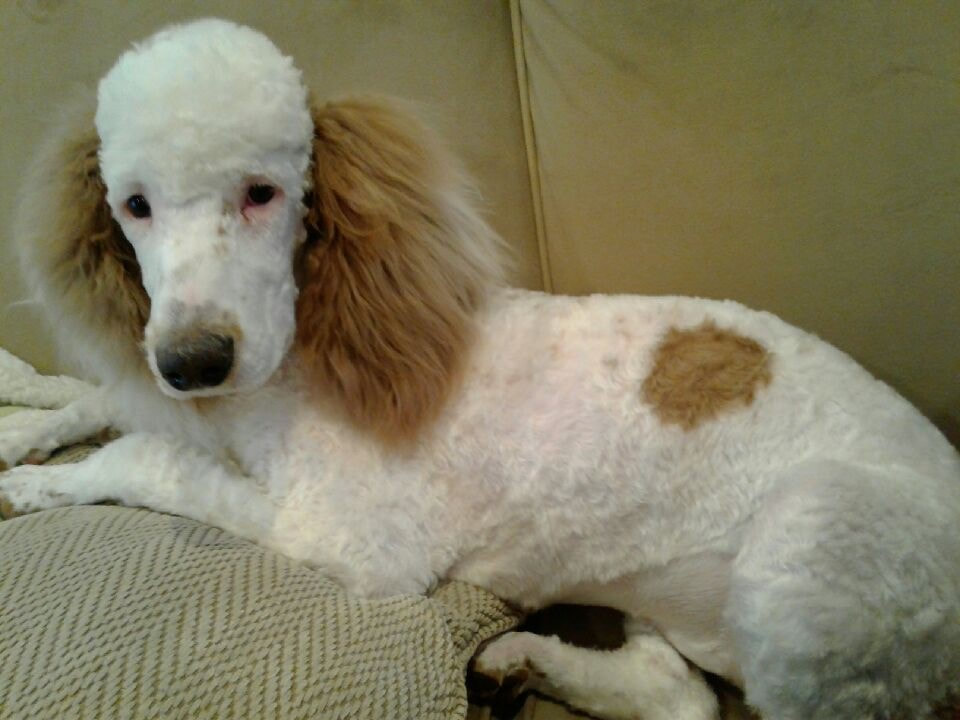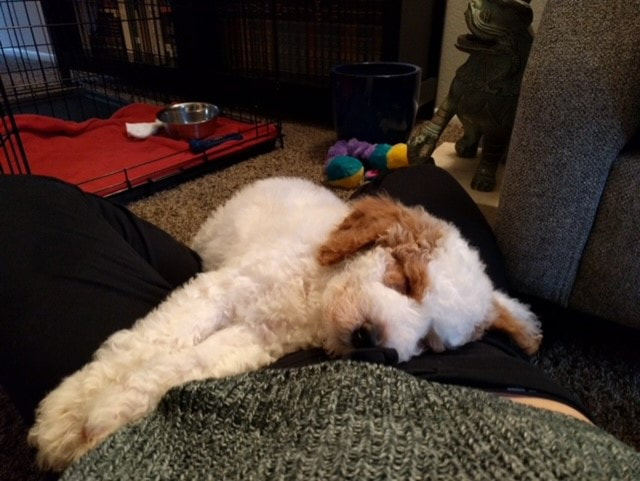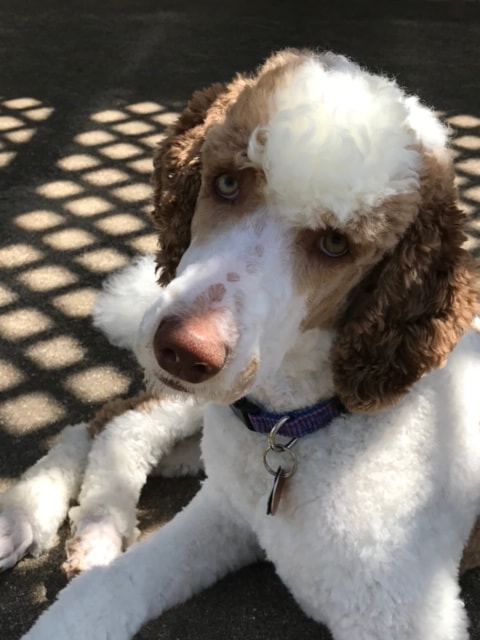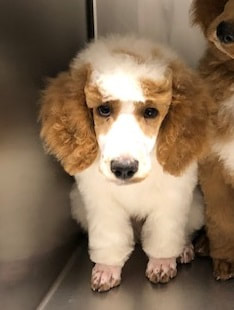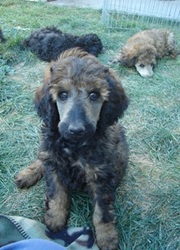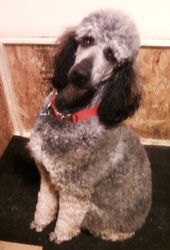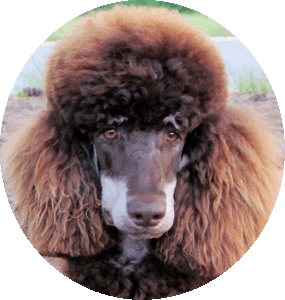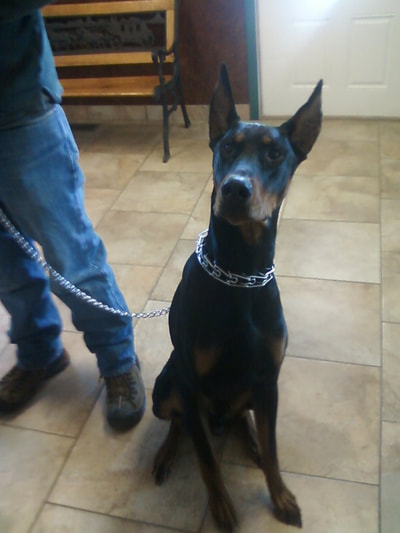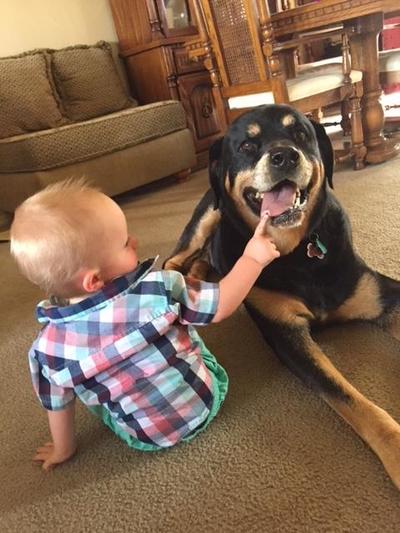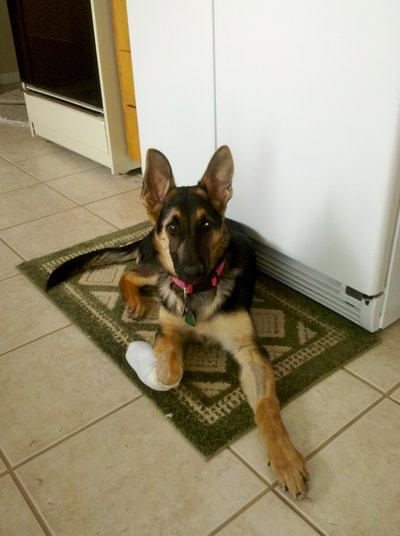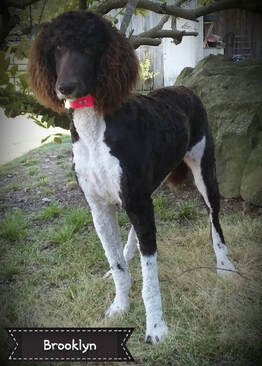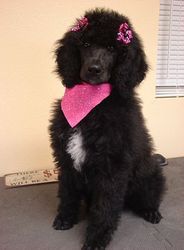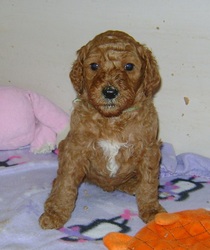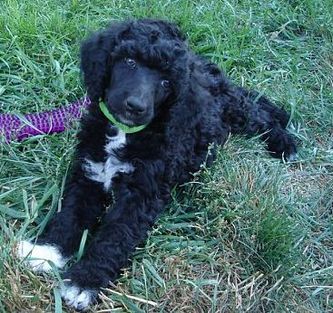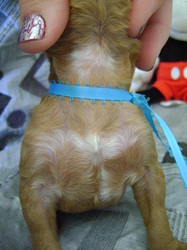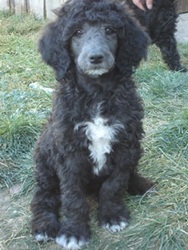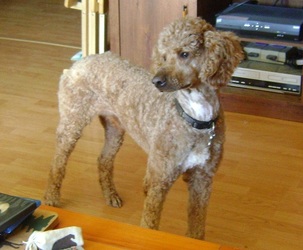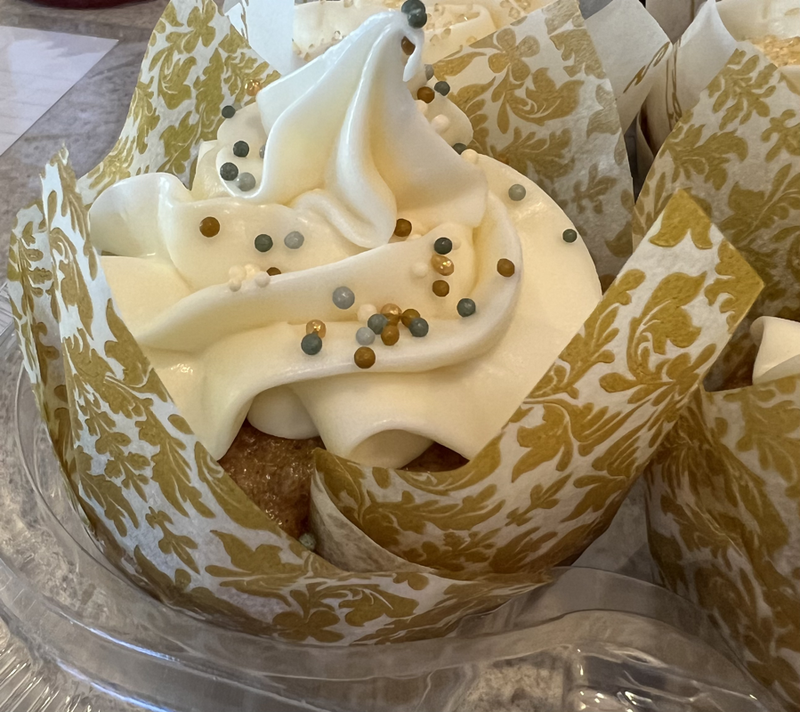~A Poodle of a Different Color~
So many colors, so little time, so much confusion! If you were at all like myself when you first got into Poodles, all the color names and technicalities confused you. Tuxedo? Parti? Phantom? What!?! Are they even pure bred if they have more than one color in them? What's the difference? I've collected some really good picture examples of most of the color schemes Poodles can have and explained them, I hope this helps your decision to get a pup.
*Remember, color is all based on genetics. It's like a magic trick, what you see is almost never what you get. The majority of poodles will look a lot different from 5 weeks old, to 5 years old. Unless you've done your research, and know exactly what you bred to, and planned it for color, it's like a box of chocolates (to quote Forrest Gump).
So don't blame your breeder, crystal balls are expensive!*
*Remember, color is all based on genetics. It's like a magic trick, what you see is almost never what you get. The majority of poodles will look a lot different from 5 weeks old, to 5 years old. Unless you've done your research, and know exactly what you bred to, and planned it for color, it's like a box of chocolates (to quote Forrest Gump).
So don't blame your breeder, crystal balls are expensive!*
~Solids~
Solids are the colors people are most comfortable with because it's what they know and it's what looks 'normal'.
There are several different colors of solid poodles. Solid means exactly that, no other color whatsoever on the dog.
There are several different colors of solid poodles. Solid means exactly that, no other color whatsoever on the dog.
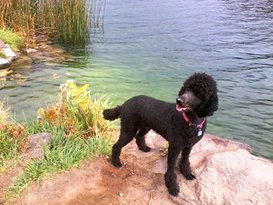
Solid Black : "Isabella"
~Black~
photo compliments of: stunninnglyss.com
It seems like a very simple, straight forward color doesn't it? Don't be fooled! True blacks are born inky black, have black points (lips, pads, nose, and eyelids) and their skin looks dark grey! When shaved for the first time, there should be no color variance in the hairs you just shaved and the longer hair. If the hair is a greyish color when shaved, the dog is more likely a 'silver'.
1st pic-Izzy as an 8 week old puppy and her BFF B.B. the kitten
2nd pic, Izzy's 1st haircut (about 10 weeks old), note that her shaved face is the same shade of black as the rest.
3rd Pic: Izzy's son 'Cosmo', before his 1st haircut. Note his face is completely black, so naturally, I was calling this puppy 'black'
4th pic Tada! It's like a magic trick! Color is not always what meets the eye. this is 'Cosmo' again after his 1st haircut (about 9 weeks). Note his face is grey now that it's shaved, this turned out to actually be a silver puppy.
photo compliments of: stunninnglyss.com
It seems like a very simple, straight forward color doesn't it? Don't be fooled! True blacks are born inky black, have black points (lips, pads, nose, and eyelids) and their skin looks dark grey! When shaved for the first time, there should be no color variance in the hairs you just shaved and the longer hair. If the hair is a greyish color when shaved, the dog is more likely a 'silver'.
1st pic-Izzy as an 8 week old puppy and her BFF B.B. the kitten
2nd pic, Izzy's 1st haircut (about 10 weeks old), note that her shaved face is the same shade of black as the rest.
3rd Pic: Izzy's son 'Cosmo', before his 1st haircut. Note his face is completely black, so naturally, I was calling this puppy 'black'
4th pic Tada! It's like a magic trick! Color is not always what meets the eye. this is 'Cosmo' again after his 1st haircut (about 9 weeks). Note his face is grey now that it's shaved, this turned out to actually be a silver puppy.
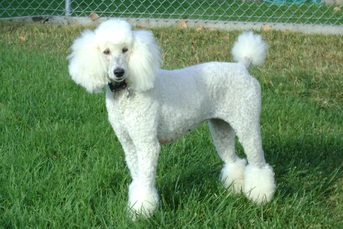
Solid White : "Echo"
~White~
photo compliments of: Stunningly Sweet Standards www.stunninglyss.com
White poodles are born exactly that, white. You can also have apricot and cream puppies eventually fade to white by the time you need to register them under their true color though, but a true white is born white, with black points.

Solid Cream : "Bentley"
~Cream~
Lighter than apricot. Many creams turn white depending on color pedigree and strength of color genes. Nose colors vary.
photo compliments of: stunninglyss.com
via Laurie Shriver-Owner of dog pictured.
Pictures below are all the same puppy.
1st pic was 1 day old.
2nd was 19 days old.
3rd was 6 weeks old.
4th is 10 months
5th is 16 months.
6th is 3 years old. Note how from about 3 weeks old to 10 months old the ears are noticeably darker. At 16 months the entire coloring of the dog is markedly lighter, and at 3 years old the dog looks an 'off white' color entirely. This can be typical of creams.
The bottom row of pictures is another SSS cream colored puppy from birth, and then every week. This puppy was from Winifred's very last litter in February of 2022.
Lighter than apricot. Many creams turn white depending on color pedigree and strength of color genes. Nose colors vary.
photo compliments of: stunninglyss.com
via Laurie Shriver-Owner of dog pictured.
Pictures below are all the same puppy.
1st pic was 1 day old.
2nd was 19 days old.
3rd was 6 weeks old.
4th is 10 months
5th is 16 months.
6th is 3 years old. Note how from about 3 weeks old to 10 months old the ears are noticeably darker. At 16 months the entire coloring of the dog is markedly lighter, and at 3 years old the dog looks an 'off white' color entirely. This can be typical of creams.
The bottom row of pictures is another SSS cream colored puppy from birth, and then every week. This puppy was from Winifred's very last litter in February of 2022.
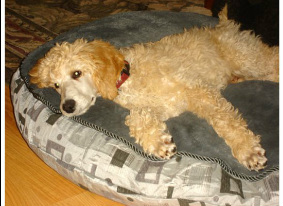
Solid Apricot
~Apricot~
Slightly Darker than Cream throughout the coat. Apricots and creams can be very hard to differentiate. Apricot is usually more of a vibrant color compared to the above 'cream' color. Nose color can vary, and the ears are usually darker than the body. Many apricots turn cream with age and fading.
photo compliments of: stunninglyss.com
*The 1st 3 pictures below are of the same Apricot puppy, Tanner (same as the above picture with natural vs indoor lighting). This puppy's father was Red and mother was white. This is a typical offspring of those 2 colors bred together.
* The next 3 pictures are of a 'light red' puppy with weak red color genes (my beloved Kayenne RIP) that grew up and faded into a dark apricot adult. You can see the similarities in the apricot puppy and 'red' puppy that faded.
Slightly Darker than Cream throughout the coat. Apricots and creams can be very hard to differentiate. Apricot is usually more of a vibrant color compared to the above 'cream' color. Nose color can vary, and the ears are usually darker than the body. Many apricots turn cream with age and fading.
photo compliments of: stunninglyss.com
*The 1st 3 pictures below are of the same Apricot puppy, Tanner (same as the above picture with natural vs indoor lighting). This puppy's father was Red and mother was white. This is a typical offspring of those 2 colors bred together.
* The next 3 pictures are of a 'light red' puppy with weak red color genes (my beloved Kayenne RIP) that grew up and faded into a dark apricot adult. You can see the similarities in the apricot puppy and 'red' puppy that faded.
~Reds~
Red's come in a variety of shades from light, to dark/mahoganey red, all based on color genetics. All photos are puppies produced by Stunningly Sweet Standards. Depending on genetics, many light, medium and regular reds, can fade to apricots and darker reds can fade to a lighter shade.
Light Red/Apricot 'Chesney' Medium Red "Marley" Regular Red "Ruby" Dark/Mahoganey Red 'Adele'
Below is my female Kayenne (mother of all puppies above). She was sold to me and pre-registered as a 'red', which at the time, she was-a very light red. Her color genetics were very weak and had many 'dilute' colors in her pedigree such as white, cream, apricot and silver. This made it so that Kayenne's reddish color as a puppy, would never hold, and she would fade with age. I knew this when I brought her home, and was fine with it because health is most important to me, color comes as a bonus. This is why I made sure to pair her with strong dominant red males with good red genes. Kayennes red genetics were there, but could not hold their weight and show through into her puppies on her own. She needed a good strong red pedigree to help her through in order to throw nicely red colored puppies. Therefore, she and all of her mates, produced a variety of red shades.
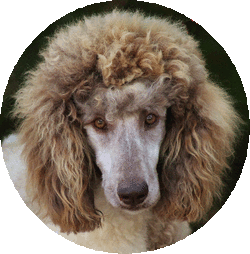
'Ivy' the Café Au Lait and white Parti
~Cafe Au Lait~
It looks like a possible mix between apricot/cream/choc. ALWAYS with a liver colored nose, this is the defining trait of a Cafe Au Lait dog, they MUST have a liver nose. A Silver Beige colored dog can have either liver OR a black nose. Café Au Lait's and Silver Beige are very easily confused, and hard to determine which is which. The main determining factor is a true Café Au Lait, is born with it's true color, Silver Beige's have to fade to their true color. Café Au Lait as an adult is also a bit darker in shade than Silver Beige.
photo compliments of: Family Affair Standard Poodles
It looks like a possible mix between apricot/cream/choc. ALWAYS with a liver colored nose, this is the defining trait of a Cafe Au Lait dog, they MUST have a liver nose. A Silver Beige colored dog can have either liver OR a black nose. Café Au Lait's and Silver Beige are very easily confused, and hard to determine which is which. The main determining factor is a true Café Au Lait, is born with it's true color, Silver Beige's have to fade to their true color. Café Au Lait as an adult is also a bit darker in shade than Silver Beige.
photo compliments of: Family Affair Standard Poodles
How can I tell if I have a Silver Beige or a Café Au Lait poodle?
Start with these questions: 1.) What color is the nose? Liver Nose = It could be either Silver Beige of Café Au Lait.
Black Nose = You have a Silver Beige Poodle!
2.) What color were they when they were born? The color hasn't changed much = Café Au Lait
Originally they were dark brown/choc. = Silver Beige
Start with these questions: 1.) What color is the nose? Liver Nose = It could be either Silver Beige of Café Au Lait.
Black Nose = You have a Silver Beige Poodle!
2.) What color were they when they were born? The color hasn't changed much = Café Au Lait
Originally they were dark brown/choc. = Silver Beige
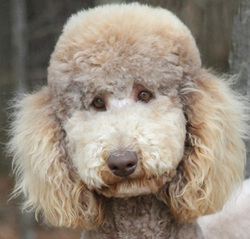
'G.G.' the Solid Silver Beige
~Silver Beige~
Silver beige starts out looking pure brown. They are a lot like Silver colored dogs because not until you shave their hair or look down into the roots, will you see the change coming. Once you shave them, you can see the cream undertones to their hair. Café Au Lait's and Silver Beige are very easily confused, and hard to determine which is which. Both can have liver noses, but a Café Au Lait MUST have one, Silver Beige can have black or liver. The main determining factor is a true Café Au Lait, is born it's original color, but a Silver Beige has to be born brown/chocolate and fade into it's true color.
photo compliments of: Family Affair Standard Poodles
All 4 pictures below are of the same dog 'Piper' a Silver Beige Toy Poodle.
1st pic: Piper as a puppy (about 8 weeks), a nice dark chocolate brown.
2nd pic: Notice how the hairs on her muzzle are starting to fade at the roots as they grow out ( about 4 months old).
3rd pic: Piper as an adult after a grooming, a completely different color than when she was a puppy.
4th pic: Another year older, after a full groom, she's even a little more silvery than the year before. This is classic of the Silver Beige. It's a very cool color. A perfect example of a color 'magic trick'.
Silver beige starts out looking pure brown. They are a lot like Silver colored dogs because not until you shave their hair or look down into the roots, will you see the change coming. Once you shave them, you can see the cream undertones to their hair. Café Au Lait's and Silver Beige are very easily confused, and hard to determine which is which. Both can have liver noses, but a Café Au Lait MUST have one, Silver Beige can have black or liver. The main determining factor is a true Café Au Lait, is born it's original color, but a Silver Beige has to be born brown/chocolate and fade into it's true color.
photo compliments of: Family Affair Standard Poodles
All 4 pictures below are of the same dog 'Piper' a Silver Beige Toy Poodle.
1st pic: Piper as a puppy (about 8 weeks), a nice dark chocolate brown.
2nd pic: Notice how the hairs on her muzzle are starting to fade at the roots as they grow out ( about 4 months old).
3rd pic: Piper as an adult after a grooming, a completely different color than when she was a puppy.
4th pic: Another year older, after a full groom, she's even a little more silvery than the year before. This is classic of the Silver Beige. It's a very cool color. A perfect example of a color 'magic trick'.
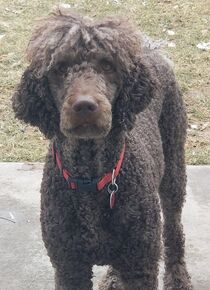
'Haus' the Solid Chocolate/Brown
~Brown/Chocolate~
Brown is another color that will fade if not properly produced with strong brown color genes. There are different shades of brown as well, lighter browns with a liver nose, to deep dark chocolate. This dog is a great example of what a nice dark brown should look like as an adult if it has exceptional color genetics. Notice how the shaved face is still just as dark as the top knot. You can notice as the hair grows out on the topknot and muzzle it is slightly lighter, this is normal as the dog ages. The dog pictured here is 6 years old.
Brown is another color that will fade if not properly produced with strong brown color genes. There are different shades of brown as well, lighter browns with a liver nose, to deep dark chocolate. This dog is a great example of what a nice dark brown should look like as an adult if it has exceptional color genetics. Notice how the shaved face is still just as dark as the top knot. You can notice as the hair grows out on the topknot and muzzle it is slightly lighter, this is normal as the dog ages. The dog pictured here is 6 years old.
~Blue~
(if you have a blue colored poodle, please contact me if you would like to feature your poodle pal here!)
Blue dogs start out looking black, then get a 'muted' tone to their coat. Like a black shirt that has been washed alot. It looks like you took black paint, added a dark blue and splash of sliver in it. An Ashy looking color. Too light to be black, and too dark to be silver. A beautiful color and somewhat rare!
(if you have a blue colored poodle, please contact me if you would like to feature your poodle pal here!)
Blue dogs start out looking black, then get a 'muted' tone to their coat. Like a black shirt that has been washed alot. It looks like you took black paint, added a dark blue and splash of sliver in it. An Ashy looking color. Too light to be black, and too dark to be silver. A beautiful color and somewhat rare!
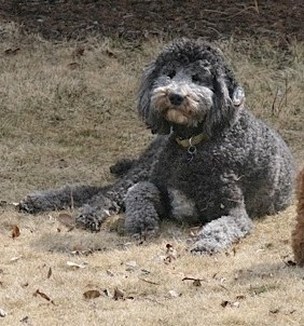
"Cosmo" 3 years old
~Silver~
aka "Grey"
photo compliments of: Stunningly Sweet Standards
Many silver dogs start out looking black. Then once you shave them, you can see the silver hair down by the roots. After several years, they completely turn.
Pictures below are the same dog 'Cosmo': 1 day old, 3 weeks old, 8wks old and then at 6 months old. Then above at 3 years old.
~Multicolors~
Mulitcolors start to raise an eyebrow or two. But rest assured that Poodles originally were more than one color. Over the years people tried to breed the multicolor out of poodles to gain just solid coloring. But for these past several decades mulitcolors are coming back and are more beautiful than ever!
Multiple colors on a poodle does NOT mean it is a mixed breed dog, DNA tests can prove this. Working in the Veterinary field for over 15 years and have a specialty in reproduction, I've learned what certain color and genetic combinations can produce.
You can have a poodle of several colors and have a purebred poodle pedigree/genes.
Multiple colors on a poodle does NOT mean it is a mixed breed dog, DNA tests can prove this. Working in the Veterinary field for over 15 years and have a specialty in reproduction, I've learned what certain color and genetic combinations can produce.
You can have a poodle of several colors and have a purebred poodle pedigree/genes.
|
~Brindle~
Brindle is a very common pattern to occur in the dog breed world, not only with Poodles but with Danes, Boxers, Mastiffs etc. Brindle can occur as any color but the unique characteristic that makes it 'brindle' are the tiger stripes! Genetically speaking, Brindle is a production of at least 2 recessive genes. This just means that it's rare, and usually has to come from both parents either displaying it in their own color, OR both parents having it close within their pedigree. Now remember, even if the above is true, you still might not get this color. There is a lot of controversy surrounding this color and the purity of the genes. DNA tests can be done on these dogs to show they are 100% poodle, however the argument can be made that brindle was |
never a 'naturally' occurring color in this breed so had to be introduced by a different breed. Therefore not making it 100% poodle. Everyone has their own opinion, everyone does their own research, just remember EVERY purebred dog and EVERY color pattern started SOMEWHERE as a MIXTURE of several things. Hundreds of years of selective breeding gave us the purebreds and color patterns of today. So don't look down your nose too far at some of these colors.
Not too long ago, I was contacted by a fellow Standard Poodle fan, Nikki, who lives in Arizona with this brindle bombshell named Lily pictured above. Lily was born May of 2020 and has fully matured into her adult coat color and texture. These pictures reveal beautifully how a brindle pattern matures over the first year. The photos from left to right are the following ages: 3.5 months, 5.5 months, 8.5 months, 10 months & 1 year. As you can see, Lily starts out as a beautiful blend of brown, tan, black and cream. In the first 2 pictures, it's very difficult to tell she is brindle. You can't see any tiger stripes and if I didn't know any better, I'd call her a Sable, just like the puppy pictured below. The only way you could tell early on is if you part the hair and look at the color of the skin. That is where the tiger stripes can be seen. By 8 months old, Lily's coat has begun to mature from soft, fluffy puppy hair to a more textured, curly adult coat. She had also received a haircut, and just like a magic trick BAM! It's like you brought home a different dog from the groomer! This feeling is common and quite shocking to many owners who don't realize the transformation so many color patterns go through. The last several months of Lily's first year of life, there is not much change in the color of her hair, but you can see that, the shorter her hair is cut, the more defined those stripes are. This is normal. Lily will retain this pattern for the rest of her life. Patterns don't fade, color may though. Her black may become a softer shade and her brown may become apricot. Only time will tell. Thank you so much Nikki and Lily for sharing these great photos!
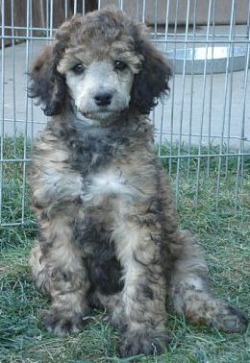
Sable Puppy 6 weeks old
~Sable~
Sable is also another common color to occur in the dog breed world like the 'Shepherd Family'. I like to describe Sable as a 'burnt toast color' most commonly brown with black tipping. Sable is the most drastic changing color scheme out there (I think). They look completely different at birth compared to 6 months old. Once fully matured, the only part of their body which held it's original color, are the ears. So if you are choosing a puppy based on color, remember, Sable puppies only have this color for a short time.
photo compliments of: stunninlyss.com
Pictured below (and above) is all the same puppy 'Roxy' from our first Stunningly Sweet Standards litter:
1st Picture:1 day old 2nd: 2 weeks old 3rd: 3 weeks old 4th: 6 weeks old 5th: 6 months old 6th: 3 yrs
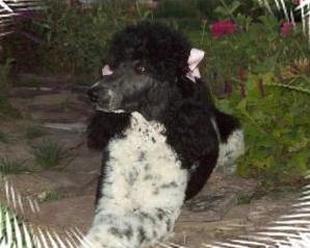
Black and White 'Parti' Poodle with Ticking
~Ticking~
Ticking is more of a 'marking' than an actual color, because you can have a dog of a certain color that also has ticking. Ticking is little specs of color all over the dog. Very much like the Sporting and Herding group of dogs.
photo compliments of: Gem State Standard Poodles
Below is 'Echo' the Wirehaired Pointing Griffon who is Liver color with Ticking. This is a great example of the color combination. The 2nd and 3rd pictures are a Red Merle Mini Aussie and a Blue Merle Tri Color Corgi, however, 'Ticking', makes up part of the Merle color scheme.
Ticking is more of a 'marking' than an actual color, because you can have a dog of a certain color that also has ticking. Ticking is little specs of color all over the dog. Very much like the Sporting and Herding group of dogs.
photo compliments of: Gem State Standard Poodles
Below is 'Echo' the Wirehaired Pointing Griffon who is Liver color with Ticking. This is a great example of the color combination. The 2nd and 3rd pictures are a Red Merle Mini Aussie and a Blue Merle Tri Color Corgi, however, 'Ticking', makes up part of the Merle color scheme.
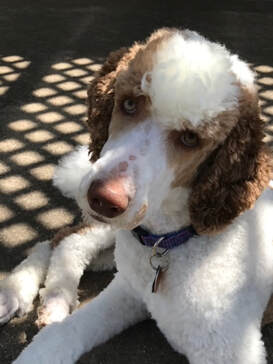
Apricot and White Parti Poodle Puppy "Newton"
~Parti~
Parti Poodles could very well be the most popular multicolored poodle available. Parti is a term that means 'Particularly' colored. A Parti Poodle is a dog that has a white base with large irregular patches of another color. Parti Poodles can come as any color or pattern in the poodle family. There are Sable Parti's, Brindle Partis etc. Pictured here is a Black and White Parti Poodle Puppy.
All poodles pictured above are Apricot and White Parti's from Stunningly Sweet Standards

Remy the Black/Tan Phantom: Poodles of the Pony Express
~Phantom~
Phantom is another Parti color pattern. Phantom colored dogs are Parti's, just specifically colored Parti's. Phantom coloring is a dog that has one main color, and then has SPECIFIC areas of another color. If you can picture the color pattern of a Rottweiler, Dachshund or a Doberman, this is the same color pattern. Phantom can occur with any color, A Silver Phantom with White points, A Chocolate phantom with Cream points, A black phantom with tan points (pictured to the left), etc etc.
1st Picture: Stunningly Sweet Standard Puppy born a red sable phantom
2nd Picture: Same dog as 1st pic, as an adult that has faded
3rd Picture: Courtesy of Family Affair Standard Poodles Chocolate and Cream Phantom
Also pictured below are a Doberman, a Rottweiler and a German Shepherd for color pattern comparison.
|
~Tuxedo~ A Tuxedo is also more a color 'scheme'. Tuxedo is a type of Parti Poodle Coloring. The characteristic of a Tuxedo Parti Poodle is a 'blanket' or 'saddle' of color over it's back. There is white from the throat all the way down the neck, on the chest, abdomen and up the underside of the tail, down the inside of the legs and up the outside of the legs. A Tuxedo can be any color. Pictured here is a female Brown and White Tuxedo named Brooklyn. She lives with her adoring mother Gina in Arkansas! |
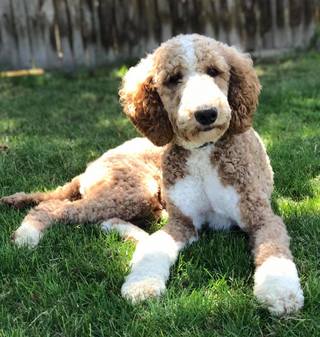
Mismark/Abstract
A Mismark or Abstract can occur with any color of poodle. This color means not enough white to be called a Parti but too much white to be called a Solid, so they deemed it 'mismark' or 'abstract'. It is any color dog with random spots of white, it does not have a white base color. Personally I think this color was named unjustly! It sounds like there is something wrong with the dog when there is not, mismarks are beautiful and I think their unique coloring gives them character and individuality! Thats why I nicknamed them 'SPLASH' Poodles, because it's just a splash of color!
Top Photo Compliments of: Stunningly Sweet Standards: Available Standard Poodle Stud, 'Monty'.
All Bottom Photos compliments of: stunninglyss.com
A Mismark or Abstract can occur with any color of poodle. This color means not enough white to be called a Parti but too much white to be called a Solid, so they deemed it 'mismark' or 'abstract'. It is any color dog with random spots of white, it does not have a white base color. Personally I think this color was named unjustly! It sounds like there is something wrong with the dog when there is not, mismarks are beautiful and I think their unique coloring gives them character and individuality! Thats why I nicknamed them 'SPLASH' Poodles, because it's just a splash of color!
Top Photo Compliments of: Stunningly Sweet Standards: Available Standard Poodle Stud, 'Monty'.
All Bottom Photos compliments of: stunninglyss.com
